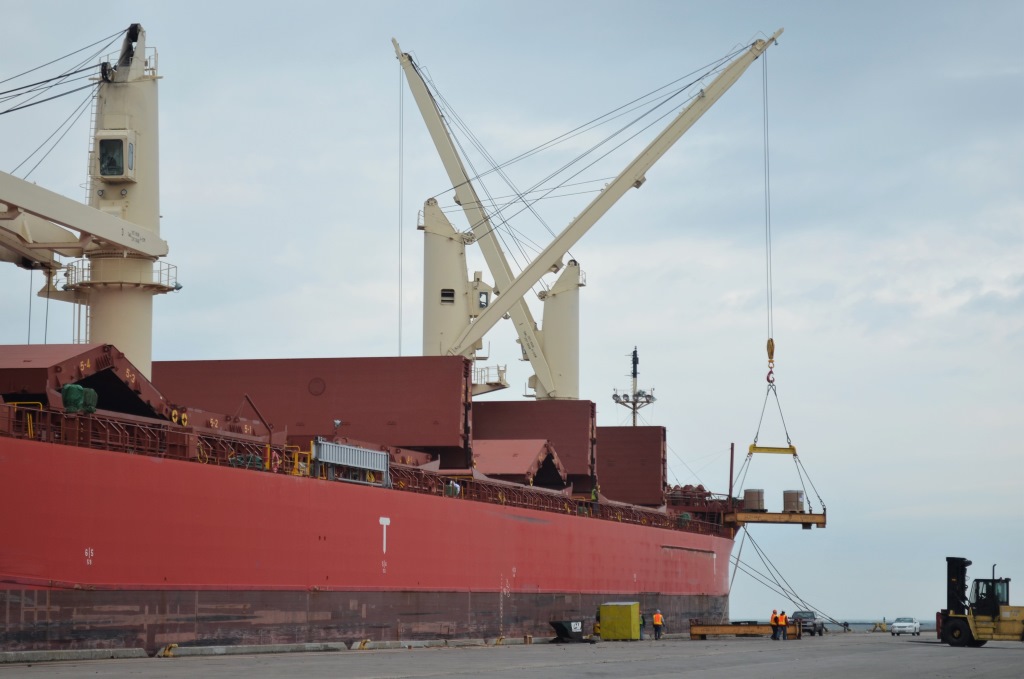Tariffs Will Hurt Business, Workers in Wisconsin
Local business, labor and university experts warn that tariffs will lead to a recession.

Unloading of the Federal Champlain. Photo by Jack Fennimore.
When President Donald Trump announced sweeping tariffs aimed at imports from most of America’s biggest trading partners, financial markets provided the first indication of the global response: panic.
Global financial markets continue to plummet. But closer to home, Milwaukee-area business and labor leaders, elected officials and economists are worried about the short term and long term impacts of the new tariff regime.
In interviews with Urban Milwaukee, all said the new tariffs will fuel inflation, raising costs for local companies, manufacturers, entrepreneurs and consumers; and that the shock waves created by the policy have the potential to send the U.S. economy into a recession.
“It’s almost unanimous concern, and I have not spoken to any business leader that’s celebrating the tariffs,” said Dale Kooyenga, President and CEO of the Metropolitan Milwaukee Association of Commerce, describing the responses he’s heard since the tariffs were announced.
The impact is registering immediately for some businesses, Kooyenga said. Like one local company he spoke with that placed a large product order. The tariff doesn’t apply to the date of purchase, but happens when the goods hit the dock in the U.S. “And so now that their order was so large and the tariff so large,” Kooyenga noted, “it creates significant cash flow issues in a time when interest rates are high.”
The new tariffs will produce a price shock for the local building and trades industry and construction budgets, said Dan Bukiewicz, President of the Milwaukee Building & Trades Council and mayor of the City of Oak Creek. “The reaction is not good,” said Bukiewicz. “From the contractors that perform construction work to small business owners that supply everything from safety vests to gloves, hard hats, safety glasses: [the price of] everything’s going up.”
Construction bids are put together at least six months in advance. The tariffs, and the uncertainty about the Trump administration’s policy going forward, will make it challenging to assemble a bid. “You can’t accurately budget for… what it’s going to take to complete a building, a bridge, a library, a museum,” Bukiewicz explained.
The Trump administration said the tariffs are meant to force industries to relocate supply chains and manufacturing to the U.S.
“Large and persistent annual U.S. goods trade deficits have led to the hollowing out of our manufacturing base; inhibited our ability to scale advanced domestic manufacturing capacity; undermined critical supply chains; and rendered our defense-industrial base dependent on foreign adversaries,” the White House said in a statement last week. “Large and persistent annual U.S. goods trade deficits are caused in substantial part by a lack of reciprocity in our bilateral trade relationships.”
This sort of relocation, however, will take years. Meanwhile businesses and workers are left to deal with the tariffs.
Some business leaders still believe the tariffs are merely a negotiating position, to secure better trade deals, Kooyenga said. “The businesses are rooting for this to be resolved quickly, hopefully get better deals than we’ve had previously, but please resolve this quickly,” Kooyenga said.
But the Trump administration, so far, has not provided the policy certainty businesses and markets prefer.
“[Trump’s] talking about, ‘we’re going to pay some higher prices, we’re going to see higher unemployment,” said Rebecca Neumann, a professor of economics at UW-Milwaukee, whose research includes a focus on international trade and finance. “We are likely heading towards a recession, all for some long term gain that I don’t think is well spelled out.”
And the magnitude and crude application of the tariffs are already causing damage, Neumann said.
“Basically, a tariff is a tax on an import,” Neumann said. The tax is paid by domestic importers once goods reach the U.S. and that additional cost is passed down the supply chain to consumers, raising prices. “Basically it just makes goods more expensive,” she said, adding that, despite the messaging of the Trump administration, foreign countries will not pay for the new tariffs, U.S. businesses and consumers will.
The Trump administration is calling the new tariffs “reciprocal tariffs,” but that’s not actually how they were designed, Neumann said. Instead, the administration appears to have simply identified countries that export more to the U.S. than they import and slapped massive tariffs on them in an effort to eliminate the trade imbalance.
“[Trade] is not a zero sum game,” Neumann said. “And this, I think, is where the problem lies in the way the administration is approaching this. They’re approaching it in a very adversarial manner.”
The new tariffs regime is unprecedented in modern U.S. history. “The model, probably, the Trump administration has in mind is early 20th century and late 19th century,” said Kundan Kishor, professor and Chair of the Economics Department at UW-Milwaukee. The modern economy, however, is far more complex than it was then.
In Wisconsin, international trade accounts for approximately 6% of the state’s total gross domestic product, with firms exporting $27.5 billion worth of goods to 201 countries in 2024. The state’s largest trading partner in terms of exports is Canada, second is Mexico. China, the state’s third largest trading partner, is the greatest importer of goods to Wisconsin. The state imported $6.4 billion worth of goods from China in 2024, and $38.8 billion goods total.
“We don’t just import finished goods,” Kishor said.
Indeed, the manufacturing and building industries in Wisconsin rely on production inputs imported from other countries. The tariffs will raise the price of these inputs for U.S. firms. “So, this whole idea of imposing tariffs and increasing U.S. exports may be defeated because it’s going to be very expensive to produce,” Kishor said.
With the cost of production increasing for companies in Wisconsin and other states, countries across the globe may begin to substitute their U.S. imports for products produced in other nations at a lower cost, Kishor explained.
The U.S. also likely doesn’t have the pool of low-skill labor available, or willing, to work low-wage manufacturing jobs. Even if it did, it’s unlikely the U.S. would ever see a return of the mid-20th century industrial economy; automation has fundamentally changed how goods are produced.
“I think that’s where there needs to be much more nuanced thinking about, how do we improve the types of jobs that people want to have now,” Neumann said. “We’re not going to just bring back heavy manufacturing in the blink of an eye.”
Instead of trying to compete with low-wage, low-skilled foreign workers, the U.S. should support industry employing high-skilled, well-paid workers, Kooyenga said.
The global economy is changing with the rise of AI and advanced automation. To be competitive, the U.S. could find more success investing in education and research and preparing its workforce for the high-tech economy, Neumann said.
Even opponents of free-trade policies, which contributed to U.S. manufacturing moving factories to take advantage of cheaper foreign labor, say the Trump administration strategy is unlikely to produce the desired outcome.
“There’s one thing that the Trump administration has gotten right, and that’s saying that access to cheap goods is not the American dream,” said Peter Rickman “But the problem here is that the tariff strategy is not going to reverse the long-term secular trends of economic policy designed to enrich corporations, the boss class, big banks and Wall Street at the expense of working people.”
The Trump administration is pursuing a policy that will raise prices in the short-term and “hurt a lot of working people,” Bukiewicz said.
And with higher prices, you get “less economic activity; less economic activity leads to layoffs; if you have layoffs, then you have more people on Medicaid… it’s just a ripple effect of what a recession looks like,” Kooyenga said.
Said Kishor: “I’m worried that the labor market may start responding and unemployment will go up.”
The tumbling stock market and devaluing dollar are signals the global community is already losing confidence in the U.S. economy, Kishor said. Stock portfolios are taking the hit right now, but rising prices and a protracted economic recession will extend the impact to the working class where people have less of a financial cushion to absorb the blow.
“Recessions hurts workers. Period. End of sentence. End of Chapter One of the Economics 101 textbook,” Rickman said. “When economic crisis hits, working class people always pay the price.”
Many communities still haven’t completely recovered from the effects of the last economic meltdown.
“You don’t have to look far down Main Street USA to see how many vacant storefronts happened after 2008 and the market failures that went on,” Bukiewicz said. “Everything is so intertwined, it’s like a spider web: If one strand is broke, it affects the entire web.”
If you think stories like this are important, become a member of Urban Milwaukee and help support real, independent journalism. Plus you get some cool added benefits.






















What caused the hollowing out of US manufacturing was the tax incentive the Reagan administration gave to US businesses. When they relocated manufacturing plants to places like China, Korea, Bangladesh, and Mexico, they were able to claim a labor tax deduction AND an overseas deduction. Tax dollars have been used throughout the 1980s-2010 to help companies move their manufacturing overseas. The tax policies of republican administrations have catered to multi-national corporations–too many of whom don’t pay taxes–at the expense of workers and small businesses.
The current administration shows no interest in the needs of American workers.